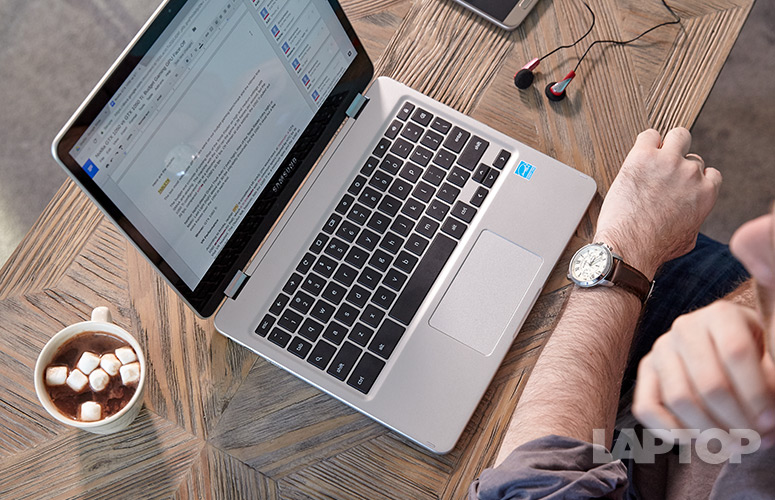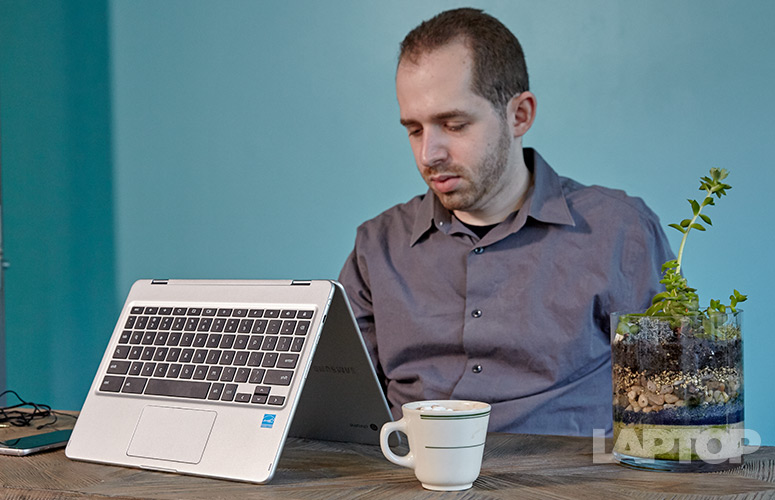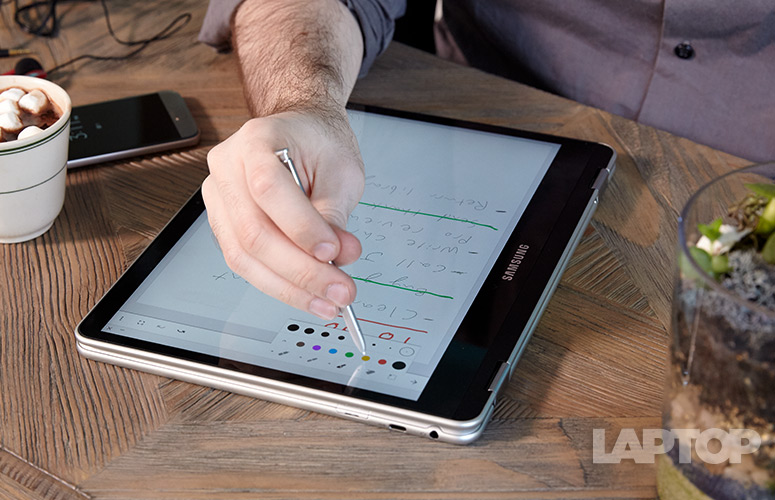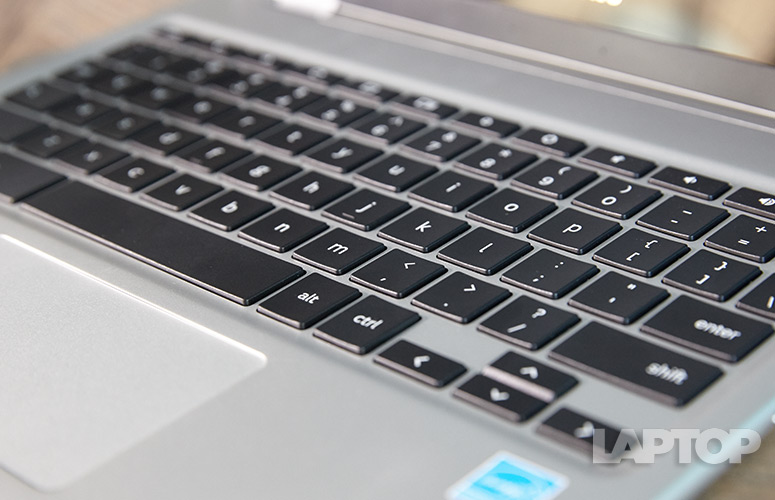Laptop Mag Verdict
The Chromebook Pro and Plus are sleek 2-in-1s with bright and sharp displays, integrated pens and solid battery life, but the Android apps need work.
Pros
- +
Super thin and lightweight
- +
Included stylus
- +
Crisp, colorful display
- +
Runs Android apps out of the box
Cons
- -
Mushy keyboard
- -
Android apps not ready for prime time
Why you can trust Laptop Mag
This review was originally published on February 24, 2017.
Update: We added a "Durability and drop test" section to this review with results from our Chromebook drop test report.
The Samsung Chromebook Plus and Pro ($449.99 and $549.99, respectively) are systems built on firsts. Nearly identical but for their processors -- the Plus has an ARM processor and the Pro has an Intel Core m3 -- they're the first Chromebooks that have embedded styli and can run Android apps out of the box, and both features add a ton of functionality to Google's lightweight operating system.
Throw in a thin, premium build and a vivid, albeit oddly shaped 12.3-inch display, and you have two of the best Chromebooks on the market right now. Being first, of course, comes with some growing pains. Some Android apps we used from the still-in-beta Google Play Store simply didn't work well. However, even if you just want Google's browser-centric operating system, the Chromebook Plus and Pro stand out from the crowd as one of the best Chromebooks.
Design
The Chromebook Plus and Pro share the same sleek and very minimalist design. The aluminum chassis isn't as wide as you would expect on most notebooks, and it took me awhile to get used to the shape. The lid is very plain, with rounded edges and no adornments, except for a monochromatic Chrome emblem and Samsung branding.
Our review unit of the Pro was a silver preproduction model, but the final version will be black. The Plus, which is on sale now, comes in silver.
Sign up to receive The Snapshot, a free special dispatch from Laptop Mag, in your inbox.
Lifting the lid reveals the 12.3-inch, 2400 x 1600 touch screen, which is unique. Rather than the average 16:9 width-to-height ratio display that most laptops use, Samsung's Chromebooks employ a 3:2 ratio, which works great as a tablet but is a bit odd for a notebook.
You still get a full island-style keyboard and a trackpad, but they're jammed into a chassis with very little room on the side. This is necessary in order to accommodate the screen's shape. I found that the Chromebook Plus and Pro felt far more natural as tablets than as notebooks, though I managed to get used to the design after several hours of use.
Because these Chromebooks are 2-in-1s, they can be used as regular notebooks, tablets (by folding the keyboard all of the way back), displays (with the keyboard face down and the display pointing forward) or tents (an upside-down "V").
MORE: Best 2-in-1s (Laptop/Tablet Hybrids)
At 2.4 pounds and 11.1 x 8.7 x 0.6 inches, these are among the thinnest and lightest Chromebooks we've seen so far -- so much so that I forgot the Pro was in my messenger bag as I carried it around. The Asus Chromebook Flip C302CA is a tad bigger, at 11.9 x 8.3 x 0.6 inches and 2.6 pounds. Acer's Chromebook R 13 is heavier (12.8 x 8.9 x 0.6 inches, 3.2 pounds), but it has a larger, 13.3-inch display.
Durability and drop test
Be careful when you hand the Chromebook Plus 2-in-1 to your child; It's not a very durable laptop. In our Chromebook drop test, the Chromebook Plus 2-in-1's frame separated from the bottom when we dropped the laptop from 2.5 feet and 4.5 feet onto carpet and concrete. Bubbling formed on the display, cracks were visible on the deck and a USB port broke when we dropped the laptop onto its side from 4.5 feet. Given the damage it sustained, the Chromebook Plus 2-in-1 scored a 5 out of 10 on our test and landed in 8th place out of 11 Chromebooks.
Ports
Chromebooks rely a lot on the cloud, so it's not a surprise that Samsung's laptops are not bursting with ports. A headphone jack, microSD card reader and a USB Type-C port are on the left, and the right side of the machine has a single USB-C port and a slot to hold the included stylus. Because the two USB Type-C ports are used for charging, you can use only one port when the laptops are plugged in.
Display
The 12.3-inch, 2400 x 1600 panel is among the most crisp and colorful I've seen on a Chromebook. When I took to the web to watch the extended, 1080p trailer for "Guardians of the Galaxy Vol. 2," I could see all of the blue veins bulging from Yondu's face, and Gamora was the perfect shade of green.
The Chromebook Pro and Plus's display reproduces 118 percent of the sRGB color gamut, surpassing the 99 percent ultraportable average, and the scores of the Chromebook Flip (76 percent) and R 13 (64 percent).
Those colors are fairly, accurate, too. The screen registered a Delta-E score of 1.0 (0 is ideal), which is better than showings by the Flip (1.6) and R 13 (1.1), and the average (2.2).
At 376 nits, the Chromebook Pro's display is far more luminous than those of the competition. The average is 304 nits, while the Flip measured 292 nits and the R 13 output 244 nits.
The screen uses a 3:2 ratio rather than a typical 16:9, which was hard to adjust to in laptop mode. However, it's perfect for a tablet, especially one with an uber-responsive touch panel.
Keyboard and Touchpad
The Chromebook Pro and Plus' island-style keyboard provides a mediocre typing experience. It has just 1.2 millimeters of travel (we prefer 1.5mm or more) and requires 52 grams of force to press (we look for a minimum of 60g). The result is a set of spongy keys and, for me, more typing errors than usual.
On the 10fastfingers.com typing test, I reached 106 words per minute, falling just short of my 107-wpm average and with a 3 percent error rate, higher than my usual 2 percent.
The 4.1 x 2.9-inch touchpad is smooth, spacious and accurate. The pad worked flawlessly as I zipped around the web and used basic gestures like three-finger swipe.
Stylus
The Chromebook Pro and Plus are the first Chromebooks to come with an embedded stylus. The pen pops straight out of a slot on the right side of the computer and looks almost identical to the S Pen that Samsung uses in its Note series of phones, just a tad longer, a little thicker and with no button to activate additional features.
Popping out the stylus automatically launches a menu (though you can shut this behavior off) with quick actions to capture all or part of the screen, start a new note in Google Keep, or use the pen as a magnifying glass or laser pointer on the screen. I used the stylus menu often, especially when taking notes. Google Keep can read the notes and use optical character recognition to make it searchable from any device.
MORE: Which Laptop CPU is Right for You?
For instance, I could look for a grocery list I made in Google Keep by searching with the words "grocery" and "list" in the note-taking app, as well as with any item on the list. The same went for a note to call friends; I just had to search their names or phone numbers.
Google claims that it has used machine learning behind the scenes so that that there won't be much screen latency when you write. I did notice some lag as I took notes in Google Keep, but I also found that my handwriting on the Chromebook Pro looked more like it does with pen and paper than on any other stylus and touch-screen combination I've tried before. The stylus is pressure-sensitive, which allowed me to make subtle changes in the lines I drew in the Adobe Photoshop Sketch Android app.
Audio
The speakers on the Chromebook Pro and Plus aren't very loud, and they struggled to fill our midsize conference room with sound. When I listened to "My Shot (Rise Up Remix)" from The Hamilton Mixtape, Black Thought, Joell Ortiz and Busta Rhymes' rapping was crystal clear, as was the backing guitar, but the piano keys were quiet and the drums weren't as snappy as I'd like.
Performance
The Chromebook Pro is powered by an Intel Core m3-6Y30 CPU, with 4GB of RAM and 32GB of eMMC storage. That's more than enough performance for multitasking. I had 16 tabs open in Google Chrome (one of which was streaming a 1080p video from YouTube) with no lag. When I opened the Twitter and HipChat Android apps, there was a split second of latency as I switched between tabs in the browser.
The Chromebook Plus uses an ARM processor, 4GB of RAM and 32GB of eMMC storage, and it's not as much of a workhorse. I had 11 tabs open in Chrome (with one streaming a 1080p YouTube video) when Chrome tabs flickered as I switched between them.
The Pro earned a score of 126.6 on the JetStream JavaScript benchmark, falling just short of the Asus Flip (Core m3-6Y30, 127.3) but handily beating the Acer R 13 (MediaTek MT8173C ARM CPU, 58.7). The Plus notched a score of 54.7 and the ultraportable category average is 164.5.
But the Chromebook Pro easily defeated its opponents on the WebGL Aquarium graphics test, rendering 2,000 fish in a tank at 48 frames per second, while the Flip notched 32 fps, The ARM-powered Plus reached 34 fps while the R 13 wavered between 20 and 40 fps.
When I played Asphalt 8, the game was generally smooth and playable on the Pro, except for one or two spots that got a bit choppy. I was still able to play the game on the Plus, but it was muddy and uneven throughout.
Chrome OS and Android
The Chromebook Pro and Plus are the first Chromebooks to support Android apps out of the box. Keep in mind that the Acer Chromebook R 11, Asus Chromebook Flip and Google's own 2015 Chromebook Pixel had early support, and every Chromebook that launches in 2017 will eventually work with Android apps.
Installing Android apps is as easy as opening the Google Play Store (which is still in beta on Chrome OS, but Google says it will be finalized by time the Chromebook Pro launches in April) and downloading apps like you would on your phone. Not every app works, though. I successfully used Adobe Photoshop Sketch, Nintendo's Miitomo, Twitter, Threes and Dark Sky, but Pokemon Go, Tinder and Signal gave notices that my device wasn't compatible with the app. In the future, I imagine most major Android apps will be compatible with these notebooks.
A lot of apps didn't play nice after being resized. Specifically, HipChat and Spotify warned that they might not work when resized, although they generally did. A few times, they snapped back to their original sizes or just refused to change size altogether. Dark Sky didn't have the option, while the game Threes flipped around the screen uncontrollably until it settled on a spot (generally sideways, which I didn't appreciate).
You can have multiple windows open with different Android apps running. Swiping down with three fingers on the trackpad makes it fairly easy to switch windows. Just keep in mind that you can't snap windows side by side as you can in Windows 10, nor is there support for virtual desktops.
A cheaper model, the Samsung Chromebook Plus, is identical in functionality, but comes in silver and uses an ARM CPU that you would usually find in tablets or phones.
I did notice one other hiccup. After saving a drawing in Adobe Photoshop Sketch, I couldn't access the image through Chrome's file system. I had to download an Android image viewer to see my artwork. Google tells me that this is a known issue that will be rectified in the M57 launch of Chrome, on March 14, before the April launch.
Still, Android apps are a very welcome addition. Otherwise, Chrome OS is mostly the same, with the browser as the main focus, a task bar at the bottom that provides easy access to programs and Wi-Fi required for the majority of apps to work. If you prefer simplicity, it's perfect, but you won't get all of the features you'll find in Windows or macOS.
Battery Life
The Chromebook Pro should last throughout your 9 to 5. The notebook endured for 8 hours and 5 minutes on the Laptop Mag Battery Test, which consists of continuous web browsing over Wi-Fi. The ultraportable average is lower, at 8:06, while the Flip (8:52) and R 13 (11:00) both outperformed the Chromebook Pro. The Chromebook Plus' battery life was just a bit shorter at 7:46. (Its weaker processor doesn't appear to save any battery power.)
MORE: Laptops with the Longest Battery Life
Webcam
The 720p webcam on the Chromebook Pro and Plus is serviceable. It's sharp and detailed, catching individual hairs on my head and creases in my shirt, but the light coming in from the windows blew out my face a bit. Colors were true, and the camera captured my shirt's exact shade of gray.
Heat
The Chromebook Pro and Plus stayed nice and cool throughout our testing, never surpassing our 95-degree Fahrenheit comfort threshold. After I streamed 15 minutes of HD video from YouTube, the bottom of the laptop hit 90 degrees, the keyboard between the G and H keys measured 86 degrees, and the touchpad reached 82 degrees.
Configuration Options and Warranty
The Samsung Chromebook Pro comes with an Intel Core m3-6Y30 CPU, 4GB of RAM and 32GB of eMMC storage, and it has a black aluminum chassis. When this notebook releases in April, it will cost $549.99.
The Chromebook Plus uses an ARM CPU that you would usually find in tablets or phones and goes for $449.99. You can purchase it now.
Both the Plus and the Pro come with one-year warranties. See how Samsung did on our Tech Support Showdown and Best and Worst Brand Ratings.
Bottom Line
The Samsung Chromebook Pro and Plus are the first Chromebooks to include an embedded stylus and support Android apps as soon as you log in. The lightweight, aluminum chassis and crisp, vivid display also help define these machines as premium 2-in-1s. However, if you don't need the stylus or premium screen, Asus's Chromebook Flip C302CA costs $50 less, has a much better keyboard and offers more internal storage; it does not come with Google Play preloaded, but you can easily get it.
At publication time, the Play Store is still in beta on Chrome OS, and has a lot of issues, including incompatibility and poor window and file management. However, Google says that the software will be out of beta and ready for primetime when Chromebook Pro ships in April. We'll retest the laptop, update this review and revisit our rating when this new version of Chrome OS launches.
Even if Google doesn't adequately improve its Android experience, the Chromebook Pro is still great as a regular Chromebook thanks to its design, build quality, and unique pen support.
Photo credit: Jeremy Lips/Laptop Mag
- 10 Tablets with the Longest Battery Life
- Best Laptops Under $500
- The Best Laptops for Business and Productivity
Samsung Chromebook Pro Specs
| Bluetooth | Bluetooth 4.0 |
| Brand | Samsung |
| CPU | Intel Core m3-6Y30 |
| Company Website | samsung.com |
| Graphics Card | Intel HD Graphics 615 |
| Hard Drive Size | 32GB |
| Hard Drive Type | eMMC |
| Operating System | Google Chrome |
| Ports (excluding USB) | USB Type-C, Headphone/Mic |
| RAM | 4GB |
| Size | 11.06 x 8.72 x 0.55 inches |
| Touchpad Size | 4.1 x 2.9 inches |
| USB Ports | 2 |
| Warranty/Support | 1 year |
| Weight | 2.4 pounds |
| Wi-Fi | 802.11ac |
| Wi-Fi Model | 802.11 ac (2x2) |
Andrew is a contributing writer at Laptop Mag. His main focus lies in helpful how-to guides and laptop reviews, including Asus, Microsoft Surface, Samsung Chromebook, and Dell. He has also dabbled in peripherals, including webcams and docking stations. His work has also appeared in Tom's Hardware, Tom's Guide, PCMag, Kotaku, and Complex. He fondly remembers his first computer: a Gateway that still lives in a spare room in his parents' home, albeit without an internet connection. When he’s not writing about tech, you can find him playing video games, checking social media and waiting for the next Marvel movie.








